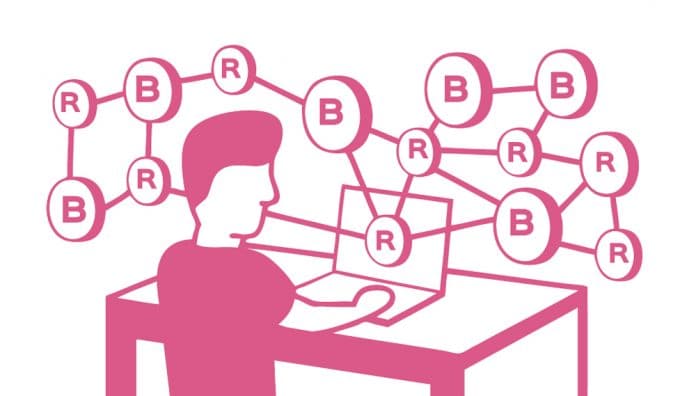It is rather difficult to understand how blockchain technology works. Blockchain in R is an effective way to understand programming and the crypto principles behind this revolutionising technology. R programming involves several objects that enable one to understand blockchain in a simpler way. It also contains several packages related to blockchain that make the entire implementation more effective.
Bitcoin, an innovative payment network, has brought fame to blockchain technology. Blockchain is considered a distributed software network that comprises a shared and trusted ledger of transactions. It allows users to trust the output of the system without trusting any actor within it by providing a universal state layer. It maintains a continuously growing list of transactions and chained blocks that are cryptographically secure from any kind of tampering. The structure of this ledger is a linked list or chain of blocks. Each block in this architecture contains a certain number of transactions that are validated by the network in a given time span. Each block also has a cryptographic hash of the prior block in the blockchain. Practically, it is very difficult to understand the blockchain at first glance.
The R programming language makes it easier to understand blockchains for even novices. The list object of the R programming language creates a block very easily. We can add different kinds of elements to this object such as an identifier, timestamp, data, parent record, and so on. With the help of the package in R, we are able to generate hash codes that are essential to each block in the blockchain. R programming provides the concept of the function that is useful for generating validation and the ‘proof of work’ kind of functionalities of blockchain.
Building a blockchain in R
Creating a block in the blockchain: A block is the starting point for the blockchain implementation. The object ‘list’ of R plays a role in the creation of a block.
The R code is:
> block1 <- list(number=1,timestamp=”May 30 2020 01:15:00”,data=”Princeton University”,parent=NA) > block2 <- list(number=2,timestamp=”May 30 2020 07:15:00”,data=”University of Oxford”,parennt=1) > block3 <-list(number=3,timestamp=”May 30 2020 09:45:00”,data=”CHARUSAT”,parennt=2) > blockchain = list(block1, block2, block3) > blockchain [[1]] [[1]]$number [1] 1 [[1]]$timestamp [1] “May 30 2020 01:15:00” [[1]]$data [1] “Princeton University” [[1]]$parent [1] NA [[2]] [[2]]$number [1] 2 [[2]]$timestamp [1] “May 30 2020 07:15:00” [[2]]$data [1] “University of Oxford” [[2]]$parennt [1] 1 [[3]] [[3]]$number [1] 3 [[3]]$timestamp [1] “May 30 2020 09:45:00” [[3]]$data [1] “CHARUSAT” [[3]]$parennt [1] 2
Validating the block: In R, user defined functions play a role to validate the block in the blockchain.
The R code here is:
validateblock = function(blockchain) {
+ if (length(blockchain) >= 2) {
+
+ if (blockchain[[2]]$parent != blockchain[[1]]$number) {
+ return(FALSE)
+ }
+
+ }
+ return(TRUE)
+ }
> validateblock(blockchain )
[1] TRUE
Hash function: Each block in a blockchain is identified by a hash value. In R, to generate hash, the digest package is to be used.
The R code is:
> library(digest) > digest(“A blockchain is a chain of blocks”, “sha256”) [1] “5c2005976411a1 628fabcdde3ac04b e563d18943e7 10b7446afa2a8a5fab9abc”
Packages for the effective implementation of a blockchain in R
R programming is the right platform to implement a blockchain in a simpler and effective manner. It contains several packages (listed below) through which we can implement a blockchain effectively.
(i) rockchain: This provides interfaces to coinmarketcap.com, the blockchain.info ticker and Bitcoin wallet data.
(ii) ether: Ethereum is another renowned cryptocurrency that has some attractive characteristics. It uses JSON-RPC API in order to communicate with the Ethereum network.
(iii) crypto: This package delivers the historic OHLC cryptocurrency market data for all coins and exchanges.
(iv) coinmarketcapr: This package helps in extracting and monitoring the price and market cap of various cryptocurrencies from CoinMarketCap.
(v) rbtc: This package provides the APIs for Bitcoin and utility functions that address the creation and content analysis of a blockchain.
The blockchain has a complex structure. Implementing it seems difficult for novices. In this article, we have provided simple guidelines using R programming, in order to implement it in a simpler way. We have discussed three main functionalities with R code for the implementation. In the first step, we looked at creating individual blocks in a blockchain using the list object of R. In the second step, we have designed a user-defined function to validate the blockchain. In the third step, we have explored how to create a hash function using the digest library of R. In addition to this, we have covered some important packages related to blockchain in R.












































































